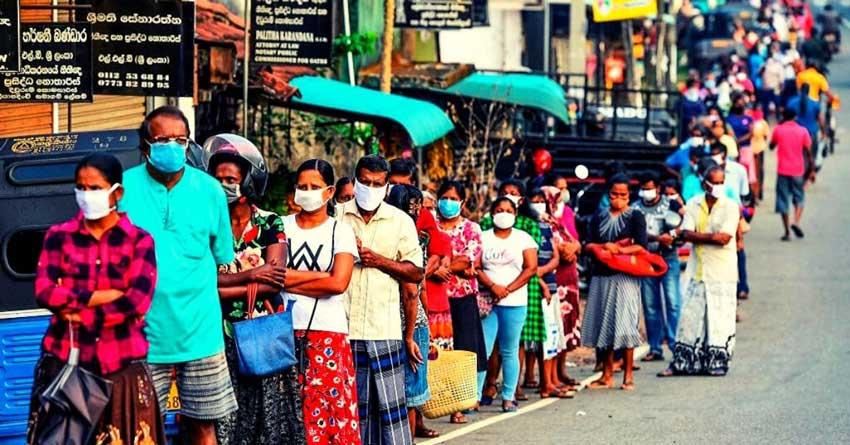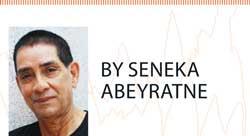Reply To:
Name - Reply Comment

 As of April 6, 2020, there are 177 confirmed cases and five deaths attributed to the coronavirus (COVID-19) in Sri Lanka. These are impressive statistics relative to those in many other countries affected by COVID-19. Physical distancing is the key to controlling the spread of the COVID-19 infection and accordingly, the island has been in curfew mode since March 20.
As of April 6, 2020, there are 177 confirmed cases and five deaths attributed to the coronavirus (COVID-19) in Sri Lanka. These are impressive statistics relative to those in many other countries affected by COVID-19. Physical distancing is the key to controlling the spread of the COVID-19 infection and accordingly, the island has been in curfew mode since March 20.
But in pursuing this course of action, the government has brought the economy to its knees. If the corporate and financial sectors are allowed to collapse, the country will fall apart. This is the fate awaiting the island, if the curfew is extended indefinitely. It is far easier to close the economy than to restart it. The economy cannot be reopened by simply pressing a button. It will take months for production, marketing and distribution, to return to normal levels.
Since manufacturing has come to a virtual standstill, the supply of domestically produced goods is decreasing day by day. To make matters worse, the government has imposed a ban on a wide range of imports. When the supply of industrial and agro-industrial goods begins to hit rock bottom, there will be hyperinflation. We should bear in mind that commodities like curry powder, turmeric powder, chilli powder, ground pepper, sugar, iodized salt, liquid milk, coconut oil, kerosene, agrochemicals and a range of Ayurvedic products, are produced largely by the domestic agro-industrial sector.
The production of toiletries has also ceased, more or less. When the country runs out of soap and toothpaste, we will be returning to the Stone Age. The supply of medicines is also rapidly dwindling, which could result in a sharp increase in the number of deaths unrelated to COVID-19, especially among the elderly.
The government is strapped for cash due to the yawning gap between revenue and expenditure and dwindling foreign reserves. If it resorts to printing money in a situation where inflation is rampant, it will be adding fuel to the fire. In March, the inflation rate was only 5.4 percent but if the curfew drags on, the average price level will begin to rise steeply, as manufactured goods and processed foods become increasingly scarce.
Due to the curfew, not only production but marketing has also been severely disrupted, particularly in respect of locally grown fresh produce. The harvesting season is on and evidence suggests that post-harvest losses have been huge in areas where the farmers have been unable to dispose of their produce. It is hard to imagine that food is being thrown away at a time like this, when hunger and deprivation are widespread.
If the economy is completely stifled, the prices will go sky-high. Hyperinflation is dangerous. The rich can absorb the shock but not the poor. Due to the curfew, the majority of low-income consumers, especially those who depend on daily wages, have little or no money to buy food. Hyperinflation will drive them into starvation and they will begin to revolt. Hence, food riots may occur in many parts of the country, if the curfew remains in force for an extended period of time.
Food riots
Food riots could also snowball into other forms, such as communal riots. Right now, the general perception is that a particular minority ethnic group is largely responsible for spreading COVID-19. Whenever the masses want a scapegoat to vent their anger and frustrations on, they will find one. A seemingly trivial incident could trigger a massive communal riot that will nullify all the efforts made by the government to win the war against COVID-19.
The curfew, which has so far been effective in combating COVID-19, could at the same time plunge the nation into political turmoil vis-à-vis a serious breakdown of law and order. It will be tragic if the government has to resort to using force to safeguard internal security. If the political fallout is major, the ruling party will no longer be confident of victory in the forthcoming general elections.
The question is how long more the curfew can continue before the economy disintegrates, hyperinflation sets in and the masses begin to revolt. If the curve pertaining to the number of people infected by COVID-19 begins to flatten out soon (an unlikely prospect), the curfew could be relaxed and the economy gradually restarted. If, on the other hand, the apex of the curve is nowhere in sight (the more likely prospect), the government will have a tough decision to make about enabling the economy to putter along as best it can under the circumstances, which means allowing a certain amount of commerce to continue and a certain number of people to continue providing essential services, health care, transportation, food and other key consumer goods.
Other key business activities that sustain an economy also need to continue, such as energy production, auto repair, financial services and manufacturing. Where there’s a will, there’s a way. The exit strategy should be bold but not reckless.
If the government is willing to implement an exit strategy on a limited scale in the near future, it will have to take a calculated risk in terms of keeping the anticipated increase in the number of COVID-19-infected patients to a manageable level. This would require the formulation of an appropriate health intervention action plan at short notice. A detailed cost estimate also needs to be prepared.
To put things into perspective: England has a population of 56 million. As of April 5, 2020, the number of confirmed COVID-19 deaths was 4,934 – a negligible proportion of the population. However, this number is increasing day by day. The British government has stated that if it could limit the number of COVID-19 deaths to a maximum of 20,000, it would be satisfied. Even this would be a tiny fraction of the population (0.04 percent).
To achieve a viable trade-off between health and economic risk in a way that does not allow the COVID-19 infection to get out of hand, is the central challenge currently facing the Sri Lankan government. What is the number of COVID-19 deaths acceptable to the government in a scenario where the supermarkets and pharmacies are reopened and selected economic activities restored in all but the high-risk areas of the country?
Like the British government, the Sri Lankan government should also define an upper limit and identify the key interventions required to keep the number of deaths within that limit. Given the need to protect its vote base as per the upcoming general elections, the ruling party will have to perform this balancing act with a judicious blend of administrative skill and political acumen. With strong and enlightened political leadership, COVID-19 can be defeated without killing
the economy.
(Seneka Abeyratne, a retired economist/international consultant to ADB/Manila, can be reached via [email protected])